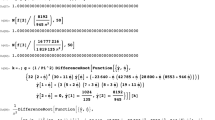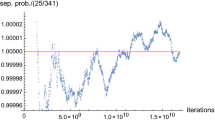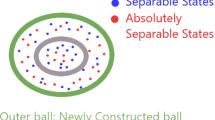Abstract
In a previous study (P. B. Slater, Eur. Phys. J. B. 17, 471 (2000)), several remarkably simple exact results were found, in certain specialized m-dimensional scenarios (m ≤ 4), for the a priori probability that a pair of qubits is unentangled/separable. The measure used was the volume element of the Bures metric (identically one-fourth the statistical distinguishability [SD] metric). Here, making use of a newly-developed (Euler angle) parameterization of the 4 × 4 density matrices of Tilma, Byrd and Sudarshan, we extend the analysis to the complete 15-dimensional convex set (C) of arbitrarily paired qubits—the total SD volume of which is known to be π8 / 1680 = π8/24 ⋅ 3 ⋅ 5 ⋅ 7 ≈ 5.64794. Using advanced quasi-Monte Carlo procedures (scrambled Halton sequences) for numerical integration in this high-dimensional space, we approximately (5.64851) reproduce that value, while obtaining an estimate of 0.416302 for the SD volume of separable states. We conjecture that this is but an approximation to π6/2310 = π6 / (2 ⋅ 3 ⋅ 5 ⋅ 7 ⋅ 11) ≈ 0.416186. The ratio of the two volumes, 8/11π22 ≈ .0736881, would then constitute the exact Bures/SD probability of separability. The SD area of the 14-dimensional boundary of C is 142π7/12285 = 2 ⋅ 71π7/33 ⋅ 5 ⋅ 7 ⋅ 13 ≈ 34.911, while we obtain a numerical estimate of 1.75414 for the SD area of the boundary of separable states.
PACS: 03.67.-; 03.65.Ud; 02.60.Jh; 02.40.Ky
Similar content being viewed by others
REFERENCES
K. ?yczkowski, P. Horodecki, A. Sanpera, and M. Lewenstein Phys. Rev. A 58, 883 (1998).
K. ?yczkowski, Phys. Rev. A 60, 3496 (1999).
K. ?yczkowski and H. J. Sommers, J. Phys. A 34, 7111 (2001).
P. B. Slater, J. Phys. A 32, 5261 (1999).
P. B. Slater, Eur. Phys. J. B 17, 471 (2000).
R. E. Kass, Statist. Sci. 4, 188 (1989).
M. Hübner, Phys. Lett. A 163, 239 (1992).
M. Hübner, Phys. Lett. A 179, 221 (1993).
S. L. Braunstein and C. M. Caves, Phys. Rev. Lett. 72, 3439 (1994).
P. B. Slater, J. Geom. Phys. 39, 207 (2001).
J. Dittmann, J. Phys. A 32, 2663 (1999).
L. C. Kwek, C. H. Oh, and X.-B. Wang, J. Phys. A 32, 6613 (1999).
A. A. Holevo, Statistical Structure of Quantum Theory (Springer, Berlin, 2001).
M. J. W. Hall, Phys. Lett. A 242, 123 (1998).
J. Dittmann, Lett. Math. Phys. 46, 281 (1998).
P. B. Slater, math-ph/0108005.
J.-L. Chen, L. Fu, A. A. Ungar, and X.-G. Zhao, Phys. Rev. A 65, 024303 (2002).
D. Petz and C. SÚdar, J. Math. Phys. 37, 2662 (1996).
G. Vidal, W. Dür, and J. I. Cirac, Phys. Rev. Lett. 89, 027901 (2002).
J. Matoušek, Geometric Discrepancy (Springer, Berlin).
H. Faure, J. Number Theory 42, 47 (1992).
G. Ökten, MATHEMATICA in Educ. Res. 8, 52 (1999).
R. F. Werner, Phys. Rev. A 40, 4277 (1989).
M. Horodecki, P. Horodecki, and R. Horodecki, Phys. Rev. Lett. 80, 5239 (1998).
V. Vedral, Phys. Lett. A 262, 121 (1999).
V. Vedral and M. B. Plenio, Phys. Rev. A 57, 1619 (1998).
R. A. Bertlmann, N. Narnhofer, and W. Thirring, Phys. Rev. A 66, 032319 (2002).
X.-B. Wang, L. C. Kwek, and C. H. Oh, J. Phys. A 33, 4925 (2000).
J.-L. Chen, L. Fu, A. A. Ungar, and X.-G. Zhao, Phys. Rev. A 6502, U822 (2002).
V. E. Mkrtchian and V. O. Chaltykian, Opt. Commun., 63, 239 (1987).
U. Fano, Rev. Mod. Phys. 55, 855 (1983).
F. J. Bloore, J. Phys. A 9, 2059 (1976).
P. B. Slater, J. Opt. B: Quantum Semiclass. Opt. 2, L19 (2000).
T. Tilma, M. S. Byrd, and E. C. G. Sudarshan, J. Phys. A 35, 10445 (2002).
P. B. Slater, quant-ph/0203088v1.
M. S. Byrd and P. B. Slater, Phys. Lett. A 283, 152 (2001).
P. B. Slater, J. Opt. B 2, L19 (2000).
P. B. Slater, J. Phys. A 32, 8231 (1999).
A. Peres, Phys. Rev. Lett. 77, 1413 (1996).
M. Horodecki, P. Horodecki, and R. Horodecki, Phys. Lett. A 223, 1 (1996).
F. Verstraete, J. Dehaene, and B. De Moor, Phys. Rev. A 6401, U3 (2001).
A. Sanpera, R. Tarrach, and G. Vidal, Phys. Rev. A 58, 826 (1998).
A. O. Pittenger and A. O. Rubin, Lin. Alg. Appl. 346, 47 (2002).
A. M. Wang, quant-ph/0002073.
N. J. A. Sloane, The On-Line Encyclopaedia of Integer Sequences, www.research.att.com/njas/sequences/index.html.
F. Verstraete, K. Audenaert, and J. Dehaene, J. Phys. A 34, 10327 (2001).
F. Verstraete, J. Dehaene, and B. De Moor, J. Mod. Opt. 49, 1277 (2002).
C. K. Caldwell, Math. Comput. 64, 889 (1995).
M. Byrd and E. C. G. Sudarshan, J. Phys. A 31, 9255 (1998).
P. B. Slater, quant-ph/0211150.
T. Tilma and E. C. G. Sudarshan, J. Phys. A 35, 10467 (2002).
D. P. DiVincenzo, B. M. Terhal, and A. V. Thapliyal, J. Mod. Opt. 47, 377 (2000).
I. Chavel, Isoperimetric Inequalities: Differential Geometric and Analytic Perspectives (Cambridge University Press, Cambridge, 2001).
F. Morgan and D. L. Johnson, Indiana Univ. Math. J. 49, 1017 (2000).
O. Druet, Proc. Amer. Math. Soc. 130, 2351 (2002).
O. Druet, Geom. Dedicata 90, 217 (2002).
J. Dittmann, Sem Sophus Lie 3, 73 (1993).
J. Dittmann, J. Geom. Phys. 31, 16 (1999).
J. Dittmann, Lin. Algebra Appl. 315, 83 (2000).
J. Dittmann, J. Lie Theory 3, 73 (1993).
D. E. Vol'per, Siberian Math. J. 38, 223 (1997).
M. Gromov, Metric Structures for Riemannian and Non-Riemannian Spaces (Birkhauser, Boston, 1999).
I. Chavel, Riemannian Geometry-A Modern Introduction (Cambridge University Press, Cambridge, 1993).
Author information
Authors and Affiliations
Rights and permissions
About this article
Cite this article
Slater, P.B. A priori Probability That Two Qubits Are Unentangled. Quantum Information Processing 1, 397–408 (2002). https://doi.org/10.1023/A:1023421914825
Issue Date:
DOI: https://doi.org/10.1023/A:1023421914825




